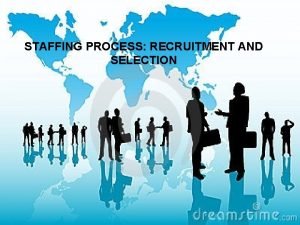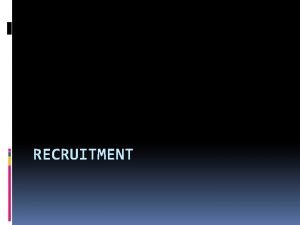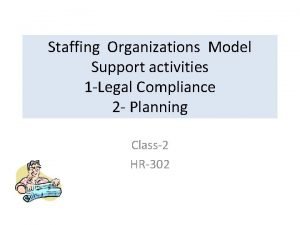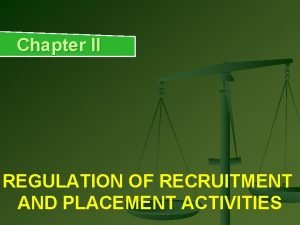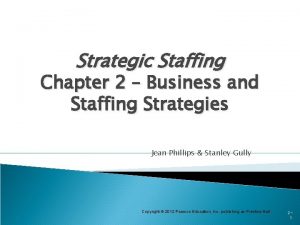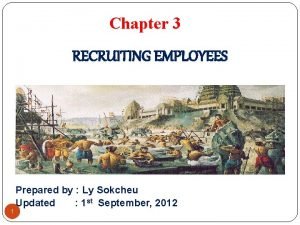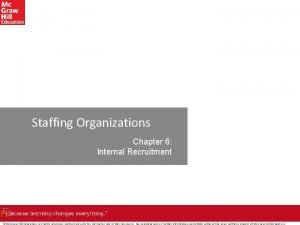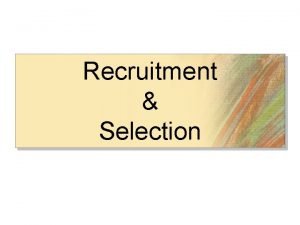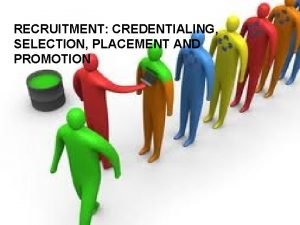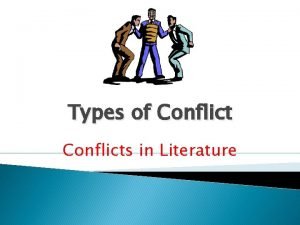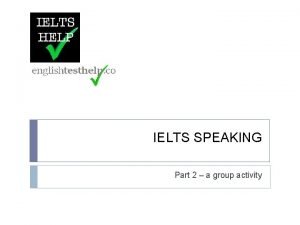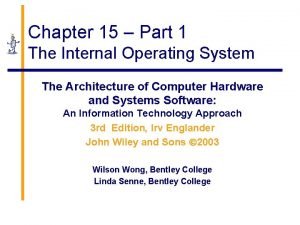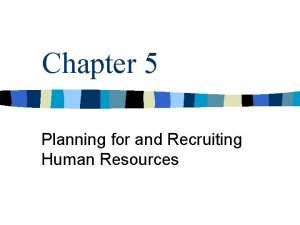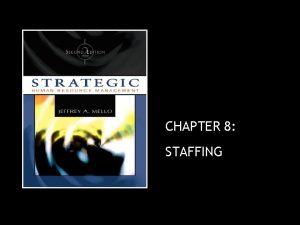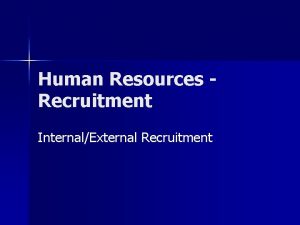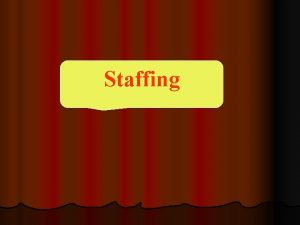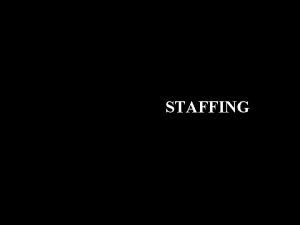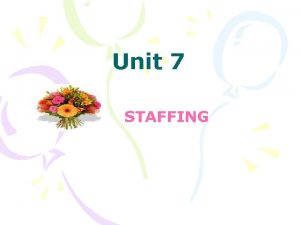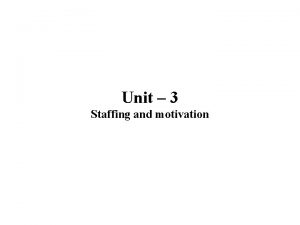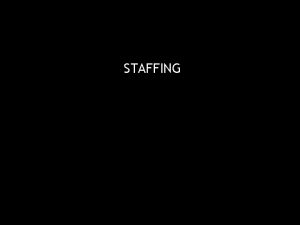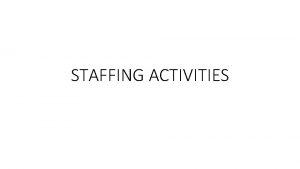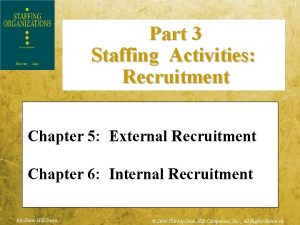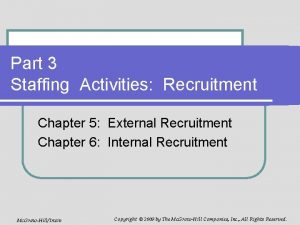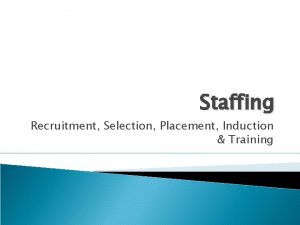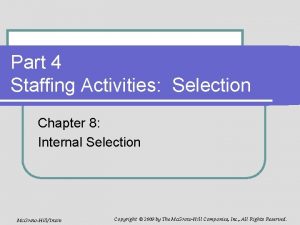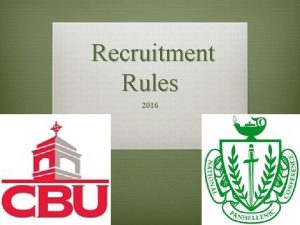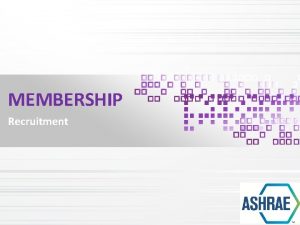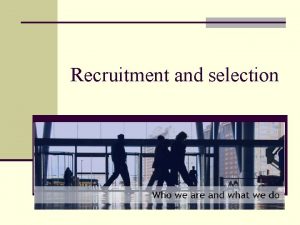Part 3 Staffing Activities Recruitment Chapter 6 Internal


























- Slides: 26

Part 3 Staffing Activities: Recruitment Chapter 6: Internal Recruitment Mc. Graw-Hill/Irwin Copyright © 2009 by The Mc. Graw-Hill Companies, Inc. , All Rights Reserved.

Staffing Organizations Model Organization Mission Goals and Objectives Organization Strategy HR and Staffing Strategy Staffing Policies and Programs Support Activities Core Staffing Activities Legal compliance Planning Recruitment: Selection: Job analysis Employment: External, internal Decision making & final match Staffing System and Retention Management 6 -2

Chapter Outline l Recruitment Planning l l Organizational Issues Administrative Issues Timing l l Strategy Development l l l Closed, Open, and Targeted Recruitment Sources Recruitment Metrics Searching l Communication Message Communication Medium Applicant Reactions l Transition to Selection l 6 -3

Discussion Questions for This Chapter l l l Traditional career paths emphasize strict upward mobility within an organization. How does mobility differ in organizations with alternative career paths? List three alternative career paths discussed in this chapter, describing how mobility occurs in each. A sound policy regarding promotion is important. List the characteristics necessary for an effective promotion policy Compare and contrast a closed internal recruitment system with an open internal recruitment system What information should be included in the targeted internal communication message? Exhibit 6. 8 contains many suggestions for improving the advancement of women and minorities. Choose three suggestions you think are most important and explain why. 6 -4

Ex. 6. 1: Hierarchical Mobility Paths 6 -5

Exh. 6. 2: Alternative Mobility Paths – alternative to move in O 6 -6

Examples: Ways to Make Work Meaningful l When upward mobility is limited by alternative mobility paths, special steps need to be taken to ensure that work remains meaningful Alternative reward systems – increment not only base on seniority but also base on knowledge & skill acquisition and contribution to O & work group l Team building- more autonomy greater challenges l 6 -7

Examples: Ways to Make Work Meaningful Counseling – workshops, self-directed workbooks, advising – to move in the organization l Alternative employment – give leave ex. to study (sabbatical) or research – to make sure E remain challenged & acquire new knowledge and skills l 6 -8

Mobility Policy l It is a specified written policies, which must be develop and should be specified eligibility criteria – for both hierarchical & alternative mobility path. 6 -9

Characteristics of a Mobility Path Policy l l l l Intent of policy is clearly communicated Policy is consistent with philosophy and values of top management Scope of policy is clearly articulated Employees’ responsibilities and opportunities for development are clearly defined Supervisors’ responsibilities for employee development are clearly stated Procedures are clearly described Rules regarding compensation and advancement are included Rules regarding benefits and benefit changes are included 6 -10

Discussion question l Traditional career paths emphasize strict upward mobility within an organization. How does mobility differ in organizations with alternative career paths? List three alternative career paths discussed in this chapter, describing how mobility occurs in each. 6 -11

Recruitment Planning: Administrative Issues l l Requisitions Coordination between internal and external efforts l l Establish internal staffing specialist positions (placement/classification professionals) to ensure consideration of internal candidates Create policies specifying number and types of candidates sought both internally and externally Budget Recruitment Guide l Ex. 6. 3: Internal Recruitment Guide 6 -12

Strategy Development: Closed Recruitment l Definition l Employees are not informed of job vacancies Advantages l Disadvantages l 6 -13

Strategy Development: Open Recruitment l Definition l l Employees are made aware of job vacancies Job posting and bidding system Advantages l Disadvantages l 6 -14

Strategy Development: Targeted Recruitment – use both open & Close l Definition l l l Advantages l l Jobs are posted, and the HR department conducts a search outside the job posting system Both systems are used to cast as wide a net as possible Thorough search is conducted People have equal opportunity to apply for postings Hidden talent is uncovered Disadvantages l Very time-consuming and costly process The large applicant pool narrowed down by KSAOs – seniority eligibility, demographics, availability of applicants 6 -15

Criteria for Choice of System A closed system is the least expensive, but may lead to high legal costs if minorities and women do not have equal access to jobs l Managers want a person to start work immediately when they have a vacancy; a closed system offers the quickest response l An open system is more likely than a closed system to identify more candidates, and hidden talent is likely to be overlooked l Some openings may require a narrow and specialized KSAO set l l l A closed system may be able to identify these people quickly An open system may be cumbersome An open system may motivate migration of employees from critical and difficult to fill jobs l Whatever system is specified in a labor contract must be followed since a contract is a legally binding agreement l An open system enhances perceptions of fairness l 6 -16

Discussion questions A sound policy regarding promotion is important. List the characteristics necessary for an effective promotion policy l Compare and contrast a closed internal recruitment system with an open internal recruitment system l What information should be included in the targeted internal communication message? l 6 -17

Strategy Development: Recruitment Sources l Job posting l Intranet and intraplacement l Talent management system l Nominations l In-house temporary pools l Replacement and succession plans l Career development centers 6 -18

Talent Management System l Comprehensive method for monitoring and tracking employee skills and abilities l l l Identify the KSAOs required for all jobs The complete set of KSAOs is compiled into a master list. The current workforce will need to be assessed for its competence in this set of KSAOs When positions come open, managers make a query to the talent management system to determine which employees are ready to come into open positions. Often coupled with specific human resources information systems (HRIS) to facilitate tracking KSAOs in the workforce 6 -19

Career Development Centers l Provide employees with opportunities to take interest inventories, assess their personal career goals, and interview with representatives across the organization l Can be an effective retention tool for employees who desire a change, but the cost is often very high so ROI should be assessed regularly 6 -20

Metrics for Evaluating Recruiting Methods Quantity l Quality l Cost l Impact on HR Outcomes l l l Employee satisfaction Job performance Diversity Retention Ex. 6. 7 Potential Recruiting Metrics for Different Sources 6 -21

Searching: Communication Medium l Job posting l Other written documents Brochures l Videocassettes l Diskettes l l Potential supervisors and peers l Informal systems 6 -22

Applicant Reactions l Minimal research regarding reactions of applicants to internal recruitment process l Perceived fairness Distributive justice - Perceived fairness of actual decision l Procedural justice - Perceived fairness of process (policies and procedures) l 6 -23

Transition to Selection l Involves l Next steps in hiring process l l making applicants aware of Selection methods used and instructions Expectations and requirements 6 -24

Discussion question l Exhibit 6. 8 contains many suggestions for improving the advancement of women and minorities. Choose three suggestions you think are most important and explain why. 6 -25

Ethical Issues l Issue 1 l l Let’s say a company called MDN Inc. is considering two employees for the job of senior manager. An internal candidate, Julie, has been with MDN for 12 years and received very good performance evaluations. The other candidate, Raoul, works for a competitor, and has valuable experience in the product market into which MDN wishes to expand. Do you think MDN has an obligation to hire Julie? Why or why not? Issue 2 l Do organizations have an ethical obligation to have a succession plan in place? If no, why not? If so, what is the ethical obligation and to whom is it owed? 6 -26
 Recruitment process stages
Recruitment process stages What is the definition of recruitment
What is the definition of recruitment Staffing organization model
Staffing organization model Activities of staffing
Activities of staffing Regulation of recruitment and placement activities
Regulation of recruitment and placement activities Staffing strategy
Staffing strategy Advantage of external recruitment
Advantage of external recruitment Definition of recruitment and selection
Definition of recruitment and selection Chartwell staffing jobs
Chartwell staffing jobs Advantage of internal source of recruitment
Advantage of internal source of recruitment Selection and placement
Selection and placement Operating activities vs investing activities
Operating activities vs investing activities Now group these activity into indoor and outdoor activities
Now group these activity into indoor and outdoor activities Primary and support activities
Primary and support activities Primary activities and secondary activities
Primary activities and secondary activities Types of internal conflict in literature
Types of internal conflict in literature Ielts speaking group
Ielts speaking group Difference between internal check and internal control
Difference between internal check and internal control Internal control and internal check
Internal control and internal check The internal part of an operating system.
The internal part of an operating system. Chapter 5 human resource planning and recruitment
Chapter 5 human resource planning and recruitment Part part whole addition
Part part whole addition Unit ratio definition
Unit ratio definition Part part whole
Part part whole What is a technical description
What is a technical description This is the centerpiece of any pouring station
This is the centerpiece of any pouring station The phase of the moon you see depends on ______.
The phase of the moon you see depends on ______.
